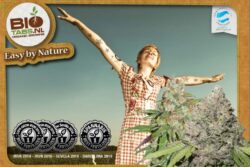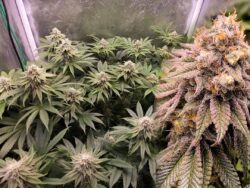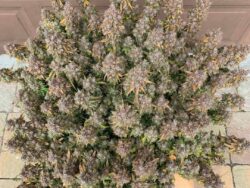SOG vs SCROG: which one is best for your grow?

SOG vs SCROG: what are the differences and which technique is best suited for your next cannabis grow?
SOG (Sea Of Green) and SCROG (Screen Of Green) are two quite different techniques which can transform the yields from your cannabis crop. The SOG method uses high numbers of plants which have been given minimal veg time. SCROG uses lower plant numbers, with long vegetative growth and a screen which is used to create a flat canopy of blooms. With SCROG, low stress training (LST) can be used to maintain a flat canopy with the use of e.g. garden cord or plastic cable ties to fix the branches to the screen. But high stress training (HST) may also be used with SCROG, e.g. topping, fimming or super-cropping your plant in combination with SCROG…
The SOG & SCROG methods are quite different in approach but they both serve the same purpose – to increase the harvest quantity. Whether you would benefit most from SOG vs SCROG depends on several factors which are explained below. The SOG method and the SCROG technique each have their own advantages and disadvantages. The best method for you will depend on your attitude to plant numbers, the type of grow room you have and the amount of time you have available for the grow cycle. Read on to find out more about SOG vs SCROG and browse the expert, in-depth Dutch Passion grower guides to SOG and SCROG cannabis cultivation.
Sea of green vs screen of green essentials
SOG and SCROG are advanced, but easy and straightforward, grow techniques designed to improve cannabis yields. Neither technique is necessarily superior to the other. The SOG method suits some growers and their cultivation style better than SCROG, and vice versa. If you have only ever grown cannabis plants in the natural way, then you may be missing out on some extra potential yield which is available by adopting the SOG and SCROG methods.
Many growers who have discovered the benefits of growing cannabis with SOG or SCROG would not switch back to growing plants naturally i.e. without grow techniques. For the reasonably experienced grower there isn’t too much extra hassle or complexity to master the relatively straightforward learning curve of the SOG and SCROG methods.
SOG and SCROG wouldn’t be recommended for first time growers, but once you have grasped the basic principles of cannabis cultivation you will find SOG or SCROG an easy way to boost yields. In fact, you may wonder why you never tried them before!
Sea of green (SOG) pros and cons
The Sea Of Green grow technique is where high numbers of cannabis plants are grown, usually in small containers, with little (or no) vegetative growth period. The result is a sea of green blooms from the numerous plants.
With little vegetative growth, the tightly packed plants don’t have time to form sizeable blooms from the side branches. Instead much of the bud production occurs on the main bloom on the central stem.
Yields per plant may be somewhat lower than you are used to, but with perhaps 4-6 times as many plants as normal the overall grow room harvest is usually superior to that from a lower number of naturally grown plants.
| PROS | CONS | ||
| ● | Faster crop cycles than SCROG, offering a great advantage for the commercial grower. | ● | For those growing in illegal areas, the high plant numbers can be stressful for some growers. |
| ● | Sogging is a perfect cultivation technique for those with smaller grow spaces. | ● | With many plants to care for, maintenance levels/watering takes longer than usual. |
| ● | Particularly (but not exclusively) suitable for indica cannabis strains. | ● | You will need lots of cuttings… or lots of seeds to achieve optimal harvests. |
| ● | SOG produces heavier yields than SCROG from the same grow room. | ● | Can be difficult to access the grow room, plants can be hard to reach and inspect/feed. |
| ● | Low crop heights mean that multi level grows can be stacked vertically on top of each other. | ● | Growing different strains together, with different plant heights and stretch rates in bloom (indicas/sativas for example), can be difficult. |
| ● | If necessary, SOG plants can be moved perhaps a little easier than a SCROG plant. | ● | Less control over the heights of individual plants, which can make it challenging to maintain a flat canopy for grow light efficiency. |
| ● | The occasional low yielding SOG plants don’t significantly affect the overall harvest quantity. | ● | You may need two grow rooms. One in veg conditions for mother plant/cuttings, and the other room in permanent bloom conditions. |
| ● | The SOG method is a fully proven grow technique with many successful users. | ● | Pests or diseases in a SOG grow can spread with depressing speed. Checking each individual plant can be tricky if conditions are cramped and access is difficult. |
Screen of green (SCROG) pros and cons
In contrast to the SOG method, the SCROG technique uses smaller numbers of plants which have been given longer vegetative grow periods. When growing with the SCROG method, the branches are weaved through the holes in a screen. Many experienced SCROG growers prefer to use a metal screen (from building merchants/DIY stores) with holes around 2-5cm (1 inch) rather than a screen made from stretched netting/cord.
SCROG plant container sizes are generally large (again, in contrast to the SOG method) which allows sufficient nutrition for a large plant which may spend a couple of months in vegetative grow conditions. With SCROG, each bloom point is exposed to light as the branches are grown under a horizontal mesh screen. Although small numbers of plants are used (perhaps just 1 or 2 per square metre) the yield per plant is increased.
Growing with SCROG pros and cons
| PROS | CONS | ||
| ● | With fewer plant numbers in SCROG you will need fewer clones. Or you will need to spend less cash on cannabis seeds. | ● | Long, slow crop cycles since the plants often have long periods of veg growth. |
| ● | You have more control over plant heights, making it easier to maintain all the blooms in the sweet spot of the grow light. | ● | Scrogging implies an extra initial hassle of adding a wire SCROG mesh (or SCROG netting) to your grow area. |
| ● | Large crops from fewer plant numbers. Useful for those worried about minimising plant numbers when growing in an illegal areas. | ● | During veg growth you need to check your plants every 2-3 days and weave the branches through the mesh screen (or tie them to it). |
| ● | Well suited to the growth of stretchy Sativa/Haze plants which could otherwise be tricky to manage in a small indoor grow space. | ● | If one of your SCROG plants (you may not have that many) performs badly it can have a serious impact on your final harvest quantity. |
| ● | SCROG can be a useful technique for those with restricted vertical growth space. | ● | You may need two grow rooms. One in veg conditions to overcome the longer VEG period, and the other room in permanent bloom. |
| ● | Watering your plants may be easier with SCROG as you have less individual plants. | ● | In case of mergency, moving a SCROG plant can be extreamely difficult if not impossible. |
SOG vs SCROG: vegetation phase
Vegetative growth is one of the main areas of difference between SOG and SCROG. With SOG, the plants are often grown in small containers, 4-6 litres is not uncommon.
Some SOG growers grow their cannabis seeds (or cuttings) under 12/12 light conditions from the start. Others will give just a week or two in veg growth before flipping conditions to 12/12 for bloom. With such high plant numbers, many growers find it cheaper to take cuttings from a mother plant rather than buy individual seeds for each plant.
With SCROG, a long period of veg growth is required. Often a grower can use 1-2 months of veg growth if they are filling a large SCROG screen. With such long periods of SCROG vegetative growth, a large cannabis root system forms and the SCROG grower will prefer very large plant containers, perhaps up to 50-100 litres. This supports the large cannabis root structure and the heavy feeding required to support (up to) several hundred grams of bud production per plant.

SOG vs SCROG: flowering phase
With SOG the yield from each individual plant is low, but this is compensated for by the high plant numbers.
In SOG flowering, much of the bud production comes from the main bloom. Side branching/growth is often minimal in the cramped multi-plant conditions with limited lateral light. The small plant containers in SOG (often 4-11 litres) don’t promote the formation of large, bushy plants. Instead the main bloom tends to deliver most of the SOG yield.
Some people grow autoflower seeds in SOG conditions with small plant containers. When planted in high numbers (small containers, little space/light for lateral side branches/growth), much of the autoflower SOG harvest comes from the main central bloom.
With SOG, the bloom process starts (almost) as soon as the plants are introduced to the grow room. SOG plants can be given a week or two of veg growth before bloom begins, but some growers don’t even do that. That means that the SOG grower doesn’t wait long between harvests and the next crop cycle.
With SCROG, the crop cycle is long. A couple of months of vegetative growth is often required before bloom can even start. But once bloom begins, the SCROG grower is able to crop huge yields from individual plants. Several hundred grams per plant isn’t uncommon for the experienced SCROG grower. In contrast, a SOG grower may only be harvesting perhaps around 30g per plant, depending on conditions.
Whether you are growing in SOG or SCROG, the normal grow room protocols have to be followed. You will need to avoid over feeding and under feeding your plants. Keeping your plants in good health and stress free is always the way to maximise quality. You will also need to ensure light intensities are good, along with plenty of fresh air exchange in your grow room throughout the bloom process.

SOG vs SCROG: yields and potency
Whether you are growing in SOG or SCROG won’t determine the potency of your final crop. The potency of your crop depends on the cannabis genetics and the quality of the grow room conditions.
If you start with the best cannabis seeds (or quality cuttings), high quality LED grow lights, controlled nutrition (without over feeding or under feeding) and a stable grow room environment then you should be set for a premium potency harvest irrespective of whether you use the SOG or SCROG method.
Whether SOG vs SCROG will yield better for a given size grow room is debatable. They are quite different techniques, but both are designed to improve grow room yields. Exceeding yields of around 600 g/m2 isn’t easy for any grower with any technique. Using SOG or SCROG will help you maximise your own grow room yields but neither technique can claim to be the best when it comes to potency or yield.
Cannabis genetics play their part in the SOG vs SCROG debate. Indica or indica dominant hybrid strains are often best suited to SOG. Whereas sativa or sativa dominant strains tend to perform best with the SCROG method. However the specific plant growth pattern and bud structure is what really defines a particular strain as suitable for either SCROG vs SOG.
You may find that using the SOG or SCROG method particularly suits your grow room and cultivation needs. If that’s the case, stick to your preferred technique and optimise it for your own personal situation and requirements.
When to grow cannabis with SOG vs SCROG
If you have grown cannabis naturally, without any grow techniques involving low stress training (or high stress training) then you have probably already mastered the basics of cannabis cultivation.
That means you will understand the basics of cannabis nutrition, grow room design, plant growth, lighting and ventilation. You may now be in a position to extend your grow skills to the advanced level, offering the hope of superior yields and perhaps improved harvest quality. SOG and SCROG are two of the easiest techniques which you can try to see if you can make a step change to the productivity of your grow room.
In terms of cash and investment, neither SOG nor SCROG should really scare the home grower. Any investments are usually minor in comparison to the value of the crop.
SOG offers some serious advantages. With fast crop cycles your SOG grow room could become more productive than ever.
| SOG Grow Guide | SCROG Grow Guide |
 |
 |
SOG vs SCROG: growers risks
One undeniable issue associated with SOG growing is the large plant numbers required to make it work well. If you feel nervous about growing 4 or 5 plants in a 1.2m x 1.2m tent then you may feel even more uncomfortable filing it with 15-20 SOG plants. The harsh reality for many people growing in illegal areas is that SOG comes with certain risks that many prefer not to take.
That’s why SCROG growing has its benefits. Especially for the home grower that perhaps prefers the idea of just having one or two plants in their grow room. If you can plan your home grows so that the longer SCROG veg period doesn’t cause you to run out of weed, then SCROG really is a great option. Especially for the home grower that just needs to grow a couple of times per year to remain self sufficient in cannabis.
If you are planning a SCROG or SOG grow you should find the challenges outweighed by the rewards and extra yield. Good luck and enjoy your growing!
| Related: |
| Top 5 cannabis strains to grow in small spaces |



















1 Comment. Leave new
Gracias por la informacion